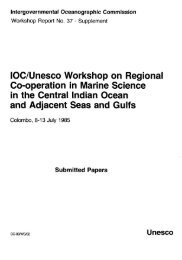Manual on sea level measurement and ... - unesdoc - Unesco
Manual on sea level measurement and ... - unesdoc - Unesco
Manual on sea level measurement and ... - unesdoc - Unesco
- No tags were found...
You also want an ePaper? Increase the reach of your titles
YUMPU automatically turns print PDFs into web optimized ePapers that Google loves.
Sea Level Measurement <strong>and</strong> Interpretati<strong>on</strong>8. New Techniques for Sea LevelMeasurements8.1 GPS <strong>on</strong> BuoysRadar altimetry is widely used for various <strong>sea</strong>-<strong>level</strong>relatedre<strong>sea</strong>rch. Owing to unknown post-launchbiases <strong>and</strong> the aging of satellite electr<strong>on</strong>ic systemcomp<strong>on</strong>ents, a c<strong>on</strong>sistent <strong>and</strong> l<strong>on</strong>g-term stable offshoreheight reference is needed. Some satellites arepassing offshore oil rigs equipped with tide gauges<strong>and</strong> GPS. However, these locati<strong>on</strong>s are rare. Withthe increasing accuracy of GPS for offshore applicati<strong>on</strong>s,various groups have developed GPS-equippedbuoys for the determinati<strong>on</strong> of the instantaneous<strong>sea</strong>-surface heights (iSSH). While in the past <strong>on</strong>lya few calibrati<strong>on</strong> experiments were carried out forradar altimetry, in 2001 GPS buoys were successfullyused during the calibrati<strong>on</strong>/validati<strong>on</strong> campaigns ofJas<strong>on</strong>-1 <strong>and</strong> ENVISAT. More recent applicati<strong>on</strong>s are fortsunami detecti<strong>on</strong> (e.g. Kato et al. 2005).One of the earlier calibrati<strong>on</strong> experiments was successfullycarried out by Hein (Hein et al. 1990).Between 1999 <strong>and</strong> 2003, GPS water <strong>level</strong> <strong>measurement</strong>was coordinated by a special study group of theInternati<strong>on</strong>al Associati<strong>on</strong> of Geodesy (see http://www.gfz-potsdam.de/pb1/op/altimetry/SSG_buoys/index.html <strong>and</strong> references herein).Depending <strong>on</strong> the type of applicati<strong>on</strong>, logistic requirements,<strong>and</strong> <strong>sea</strong> state, different types of buoys are used.The most simple <strong>and</strong> straightforward types are lifesavertypebuoys fitted directly with a GPS antenna (Wats<strong>on</strong>et al., 2004; Figure 8.1), <strong>and</strong> towed by, for example, avessel. Larger buoys, such as toroid buoys (Schöne etal., 2001; Figure 8.3) or barrel buoys, can be mooredfor l<strong>on</strong>g-term applicati<strong>on</strong>s, but are in need of additi<strong>on</strong>alsensors to account for the buoy movement. Examplesof height time-series from GPS buoys are shown inFigures 8.2 <strong>and</strong> 8.4.To estimate the iSSH, GPS <strong>measurement</strong>s are used ina differential mode. The computed value is furthercorrected for the dipping <strong>and</strong> the tilting of the buoy.The accuracy of GPS for the height comp<strong>on</strong>ent isbetter than a few centimetres, allowing very precise<strong>measurement</strong>s of the iSSH. Even with a decrease inaccuracy with increasing distance from the GPS referencestati<strong>on</strong> at the shore, the resulting iSSH values areprecise enough for calibrating radar altimeters.With the technological advances in hardware <strong>and</strong> newdevelopments in GPS processing, small lightweightsystems will be available to support the massive applicati<strong>on</strong>in different fields. Fields of future re<strong>sea</strong>rch arethe applicati<strong>on</strong> of precise point positi<strong>on</strong>ing techniquesto reduce the amount of data to be transferred, lowpowerc<strong>on</strong>sumpti<strong>on</strong> equipment, <strong>and</strong> new data transfertechniques for offshore applicati<strong>on</strong>s.IOC <str<strong>on</strong>g>Manual</str<strong>on</strong>g>s <strong>and</strong> Guides No 14 vol IV45
















